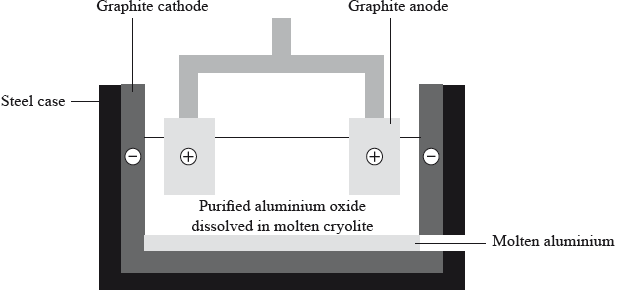| Date | November 2014 | Marks available | 4 | Reference code | 14N.3.hl.TZ0.9 |
| Level | HL | Paper | 3 | Time zone | TZ0 |
| Command term | Deduce and Suggest | Question number | 9 | Adapted from | N/A |
Question
Aluminium is chemically reactive so it has to be extracted by the electrolysis of aluminium oxide dissolved in molten cryolite.

(i) Suggest why the aluminium oxide is dissolved in molten cryolite.
(ii) Deduce an equation for the discharge of the ions at each electrode.
Positive electrode (anode):
Negative electrode (cathode):
(iii) Suggest why the anodes have to be replaced at regular intervals.
(i) Outline why aluminium is alloyed with copper and magnesium when used to construct aircraft bodies.
(ii) State two properties of aluminium that make it suitable for use in overhead power cables.
Markscheme
(i) lowers operating temperature of cell;
improves conductivity of the melt;
Accept “lowers the melting point (of aluminium oxide)”.
Accept “uses less energy”.
(ii) Positive electrode (anode):
\({\text{2}}{{\text{O}}^{2 - }} \to {{\text{O}}_{\text{2}}}{\text{(g)}} + {\text{4}}{{\text{e}}^ - }/{{\text{O}}^{2 - }} \to \frac{1}{2}{{\text{O}}_{\text{2}}}{\text{(g)}} + {\text{2}}{{\text{e}}^ - }/{\text{2}}{{\text{O}}^{2 - }} - {\text{4}}{{\text{e}}^ - } \to {{\text{O}}_{\text{2}}}{\text{(g)}}/\)
\({{\text{O}}^{2 - }} - {\text{2}}{{\text{e}}^ - } \to \frac{1}{2}{{\text{O}}_{\text{2}}}{\text{(g)}}\);
Allow C(s) – 2O2– \( \to \) CO2(g) + 4e–.
Negative electrode (cathode):
\({\text{A}}{{\text{l}}^{3 + }} + {\text{3}}{{\text{e}}^ - } \to {\text{Al(l)}}\);
Accept e instead of e–.
Ignore state symbols.
If correct equations shown at wrong electrodes, award [1 max].
(iii) the carbon anode oxidises / burns in/reacts with the oxygen (to produce \({\text{C}}{{\text{O}}_{\text{2}}}\));
(i) harder/stronger (than pure aluminium);
(ii) Award [1] for any two of:
good conductor of electricity;
resists corrosion;
Do not allow rusting.
low density;
Do not allow lighter/light mass/light weight.
ductile;
Do not allow malleable.
Examiners report
The reason for adding cryolite was well known but the electrode equations were shaky, particularly balancing the equation at the positive electrode (anode). Most had a good idea of why the anodes would need to be replaced from time to time. The strength of the alloy was understood but candidates needed to see that two properties were required for one mark in (b) (ii) – and light or lightweight was not accepted. In (c), the environmental impacts were not well done, very generic and not specific to this process.
The reason for adding cryolite was well known but the electrode equations were shaky, particularly balancing the equation at the positive electrode (anode). Most had a good idea of why the anodes would need to be replaced from time to time. The strength of the alloy was understood but candidates needed to see that two properties were required for one mark in (b) (ii) – and light or lightweight was not accepted. In (c), the environmental impacts were not well done, very generic and not specific to this process.

